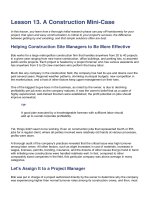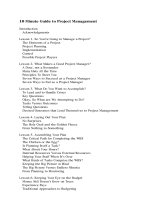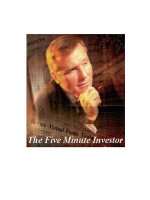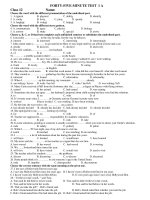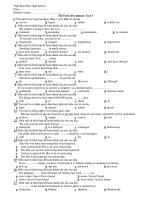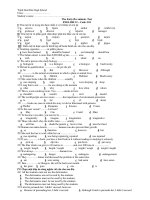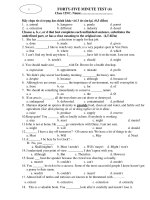Margret geraghty five minute writer
Bạn đang xem bản rút gọn của tài liệu. Xem và tải ngay bản đầy đủ của tài liệu tại đây (638.16 KB, 193 trang )
Published by How To Content,
A division of How To Books Ltd,
Spring Hill House, Spring Hill Road,
Begbroke, Oxford OX5 1RX, United Kingdom.
Tel: (01865) 375794. Fax: (01865) 379162
www.howtobooks.co.uk
How To Books greatly reduce the carbon footprint of their books by sourcing their typesetting and
printing in the UK.
All rights reserved. No part of this work may be reproduced or stored in an information retrieval system
(other than for purposes of review) without the express permission of the publisher in writing.
The right of Margret Geraghty to be identified as the author of this work has been asserted by her in
accordance with the Copyright Designs and Patents Act 1988.
© 2009 Margret Geraghty
First edition 2006
Second edition 2009
First published in electronic form 2009
British Library Cataloguing in Publication Data
A catalogue record for this book is available from the British Library
ISBN 978 1 84803 325 2
Cover design by Baseline Arts Ltd, Oxford
Produced for How To Books by Deer Park Productions, Tavistock, Devon
Typeset by PDQ Typesetting, Newcastle-under-Lyme, Staffs.
NOTE: The material contained in this book is set out in good faith for general guidance and no liability
can be accepted for loss or expense incurred as a result of relying in particular circumstances on
statements made in the book. The laws and regulations are complex and liable to change, and readers
should check the current position with the relevant authorities before making personal arrangements.
Contents
Introduction
v
The Exercises
1 The power of ritual
2 What are you waiting for? Make a list
3 Playing tag in the schoolyard
4 101 uses for ...
5 What makes you happy?
6 No time to write?
7 Rediscovering your child’s eye
8 Turning points
9 If fate hands you a rattlesnake, make a handbag
10 Rewriting cliche´s
11 One minute – one sentence
12 The name of the game
13 Turning stains into stories
14 Unfinished sentences
15 Fill in the blanks
16 Time after time
17 Truly sumptuous
18 Last line triggers
19 What if?
20 Gimme the money
21 Writing with colour
22 Public places, private memories
23 Are you too fond of backstory?
24 Be a character whisperer
25 Take a chance
26 Two-faced characters
27 Change your life – buy a new pair of jogging shoes
28 Crack the shell
29 Who’s calling, please?
30 250 words on something
31 Turn your worst moments into money
iii
1
4
6
10
15
18
21
25
28
32
35
38
42
45
48
49
52
54
56
60
65
69
74
76
79
82
85
88
92
95
97
iv / T H E F I V E - M I N U T E W R I T E R
32
33
34
35
36
37
38
39
40
41
42
43
44
45
46
47
48
49
50
51
52
53
54
55
56
57
58
The three-mountain solution to point of view
Reframing repulsive characters
Say ‘no’ to crocodile tears
Daisy chain stories
The cafe´ of life
It’s in the bag
The taste of success
Choice and consequence – two magic ingredients
What do you care about?
Beautiful words
Not-so-beautiful words
Plunge-in beginnings
Writing with titles
Visual dialogue
You can write a story in five minutes
For a satisfying ending, try a tin of magnolia
How to plump up ‘thin’ characters
Please insert address
What does this feel like?
Food for thought
So what do you do for a living?
We’re all part of a system
What do you want † really?
Opposition creates meaning
The age of epiphany
Setting as character
Decisions, decisions
Sources of last lines in Exercise 18
99
103
108
114
118
121
123
127
131
133
134
135
138
141
144
148
151
155
158
160
163
167
170
172
176
179
182
186
Introduction
This book grew out of my desire to create new and exciting
exercises for my creative writing students. I also wanted to open
doors in their minds, to encourage them to explore the power and
possibilities of the written word. During the 16 years I’ve been
running writers’ workshops, I’ve become fascinated by the
connections between fiction and other disciplines, psychology in
particular. Could psychology provide answers to the questions all
writers ask, such as: ‘Where do ideas come from?’, ‘Why have the
same basic plots survived since the beginning of time?’, ‘Can I
learn to think more creatively?’
Since both psychology and fiction are dedicated to exploring the
human mind, I set about exploring the links while I was studying
for my degree in psychology. This proved fruitful. While Jungian
studies gave me insight into the archetypal nature of fiction,
cognitive psychology helped me to understand how the brain
works and how it’s possible to model the thought processes of
creative geniuses. We can’t all be geniuses. What we can do is to
practise the kind of thinking that has been shown to foster
creativity. I devised exercises to do precisely that.
I was also getting answers to many of the problems that beset
beginner writers. For example, I learned that the reason it’s so
difficult to find the right words to elicit emotion in a reader is
that emotions are experienced in an area of the brain that is
dumb. Typically, we do not intellectualise emotions. We feel them.
It’s only when trying to convey our emotions to others that we
struggle with words. And in an effort to convey this feeling, we
v
vi / T H E F I V E - M I N U T E W R I T E R
find that all we can describe are the physical symptoms – the
pounding heart and the sweaty palms. I looked at ways to ditch
the sweaty palms.
My research widened to include other disciplines – linguistics, art,
film, and advertising, many of which were a rich source of ideas. I
found nuggets of gold in unlikely places. A sociological study into
the flight-training techniques of Delta Airlines, whose cabin crew
have to deal with ‘difficult’ passengers, was the inspiration for an
exercise designed to help writers deal with dislikeable characters.
This book brings the fruits of my research together. It’s designed
to inspire you to write – even if you only have a few minutes to
spare. Each chapter offers you a writing-related discussion
followed by a five-minute exercise. Five minutes a day spent on an
exercise is one of the most effective methods I know to explore
your potential and develop self-discipline. The book will help you
to:
X
X
X
X
X
X
X
Access your inner self, the personal memories that reflect
universal patterns of the total human ‘story’.
Develop a writing routine.
Understand the nature of fiction as a cultural product.
Recognise life as an inexhaustible source of story ideas.
Stimulate creative thought.
Develop whole-brain techniques for ‘jumping outside the box’.
Remove blocks.
I hope you will enjoy using this book as much as I have enjoyed
writing it for you. Dip in. Pick a page and begin your writer’s
journey.
1
The Power of Ritual
I like bars just after they open for the evening. When the air
inside is still cool and clean and everything is shiny and the
bar-keep is giving himself that last look in the mirror to see if
his tie is straight and his hair is smooth. I like the neat bottles
on the bar back and the lovely shining glasses and the
anticipation. I like to watch the man mix the first one of the
evening and put it down on a crisp mat and put the folded
napkin beside it. I like to taste it slowly. The first quiet drink
of the evening in a quiet bar – that’s wonderful.
Raymond Chandler, The Long Goodbye
At first sight, this is a strangely uneventful piece of prose.
Raymond Chandler’s novels are usually regarded as masterpieces
of slick-talking and fast action. So, what’s happening here?
What’s it all about?
It’s about ritual and its significance to us as human beings. When
we think of rituals, the first things that come to mind are things
like religion or festivals, but a ritual can be anything that we
always do in a particular way. American market researchers have
discovered that late-night ice cream eating has ritualistic
overtones, with people often using a favourite bowl and spoon.
When a teenage girl brushes her hair one hundred times every
day, that’s a ritual. Making coffee is a ritual, particularly if you
have one of those fancy cappuccino machines.
1
2 / THE FIVE-MINUTE WRITER
Rituals add structure to our lives. Some give us pleasure and part of
that pleasure is the anticipation. Note how Marlowe, the viewpoint
character in the extract, likes to taste his first drink of the evening
s-l-o-w-l-y, savouring the pleasure. Note all the sensuous detail: the
cool air, the shining glasses, the crisp mat, the quiet bar. Those
details add atmosphere and enable us to share the pleasure. In an
uncertain world, rituals provide an edge of comfort and stability.
Advertising agencies exploit this phenomenon in order to make
people feel warm and receptive to their products. One car
commercial for example, featured a man and a woman and their
different attitudes to the car that they share. The woman likes the
car tidy. She impatiently removes a cassette from the deck and
bundles a spilt packet of sweets into the glove compartment before
driving off. Later, when the man takes possession, he replaces the
tape, retrieves his sweets and pops one in his mouth. He smiles.
Those are rituals.
In a similar way, writers can use rituals and ritualistic behaviour
to create a bond or a bridge between the readers and the fictional
world contained in the novel. Take another look at the Chandler
extract. The preceding chapter ends like this:
He would have told me the story of his life if I had asked him.
But I never asked him how he got his face smashed. If I had
and he told me, it just possibly might have saved a couple of
lives. Just possibly, no more.
This is outside the experience of most readers. Most of us,
however, have visited a bar and experienced the pleasure of a first
drink. Although it’s fiction, the scene has its own truth. Everyone
can relate to it. As a result, that truth transfers itself to the book
as a whole.
THE POWER OF RITUAL / 3
THE EXERCISE
Think about the rituals and ritualistic behaviours in your own life. A ritual can
be anything that involves a fixed routine or sequence of behaviours. Try
starting with a creative search to jump-start your ideas. Then, write for five
minutes on your chosen ritual. Remember that the most effective way of
getting it across to the readers is to make the writing simple, but graphic.
Readers don’t necessarily have to be familiar with your particular ritual but
they must be able to relate to it.
2
What AreYou Waiting For?
Make a List
Think of all those odd minutes in the day you spend waiting for
something: a kettle to boil, traffic to clear, trains to arrive,
entertainments to start, etc. And what about people: the dentist,
the doctor, the optician, the supermarket check-out operator, the
post office clerk, the waiter, the waitress, the children, the
children’s teacher? All these people keep you waiting. The
individual slices of time may not be long, but if you add up those
minutes, you may be surprised at how much you lose. Next time
you find yourself waiting, start a list. I’m not talking about
shopping lists but lists you can use as catalysts for your writing,
words and thoughts that have meaning for you. The beauty of lists
is that they fit into the cracks of your day and you will find that
many of the exercises in this book make use of lists. You can start
and stop as often as you want. And at the end, you have
something to show for those lost chunks of time.
4
WHAT ARE YOU WAITING FOR? MAKE A LIST / 5
THE EXERCISE
To get you into list-making mood, here are some ideas.
X
List your pet hates/irritations.
X
List what you’d grab if your home was on fire.
X
List some positive things about yourself.
X
List your favourite childhood books.
X
List your wishes.
X
List the things you could never forgive.
X
List your worries.
X
List those feelings you’d rather not deal with.
X
List some metaphors for sunset. The sunset looked like ...
X
List the best presents you ever received.
X
List some smells that have special meaning for you.
X
List the things in your wardrobe you never wear.
X
List the people you admire.
X
List what you’d do if you won a million pounds.
X
List some things you’d change about yourself if you could.
3
PlayingTag in the Schoolyard
Take a look at the above ‘picture’. What do you see? Nothing
much? In fact, this is a copy of a sheet of paper produced during
a psychological experiment into creativity (Getzels and Jackson
(1962) Creativity and Intelligence: Explorations with Gifted
Students). The participants, all children, were asked to draw a
picture entitled ‘Playing Tag in the Schoolyard’. Most of the
children filled their pictures with lots of details. They drew school
buildings and added labels. The child who produced the above
picture returned the blank sheet of paper with the title changed to
‘Playing Tag in the Schoolyard – During a Blizzard’.
The experimenters considered this child to be a more creative
thinker than those who had completed the assignment along
traditional lines. Whether anyone would be willing to pay good
money for her artistic achievement is another matter! However,
one thing is true. In jumping outside the box, this child
demonstrated her ability to free herself from the specific details of
instructions and yet still produce something that met the brief.
6
PLAYING TAG IN THE SCHOOLYARD / 7
As writers, we, too, struggle to free ourselves from creative ruts.
All the stories in the world have already been told, and in many
different forms. Joseph Campbell writes in The Hero with a
Thousand Faces:
The latest incarnation of Oedipus, the continued romance of
Beauty and the Beast, stand this afternoon on the corner of
Forty-second Street and Fifth Avenue, waiting for the traffic
light to change.
If we want to create something fresh, then, what is the answer? If
you are tempted to say ‘Produce a book with blank pages’ you
may be surprised to learn that this has already been done. The
book (which I found in the wedding gift section of a posh kitchen
store) is entitled What Men Understand About Women. I have no
idea whether it became a best-seller, but I’d hazard a guess that
quite a few people bought it as a joke.
The bottom line here is that innovative products – be they
wedding gifts, art, or popular novels – begin with innovative
thinking. The good news is that, like all thought processes, we can
train ourselves to get better at it. Indeed, research into the
characteristics of highly-creative people reveals that creativity is
not a single attribute. Rather, it is a combination of attributes,
including – among others – fluency, flexibility, and originality.
There are many exercises in this book designed to target these
different aspects of creativity, and if you practise them regularly
they will work for you.
Let’s focus on originality. This is characterised by the ability to
come up with ideas that are statistically unusual. Easier said than
done? The good news is that you can train yourself. Psychologists
8 / THE FIVE-MINUTE WRITER
have found that people who regularly come up with original ideas
are also good at ‘remote association’, meaning the ability to form
connections between things that appear to have no previous
association and are remote from each other in time and/or space.
This, by the way, is the thought process behind the creation of
metaphor. For example, when poet Craig Raine wrote that a
crescent moon at morning ‘fades like fat in a frying pan’, he was
making a remote association between the moon and a piece of
lard. The following exercise will get you started on a few remote
associations of your own.
PLAYING TAG IN THE SCHOOLYARD / 9
THE EXERCISE
Make a list of concrete nouns. By concrete, I mean things that are visible.
Fish, tree, fire and comb are concrete nouns. Wealth is not. Nor is hunger or
disappointment. Now, take the abstract noun, life, and try forming remote
associations between it and each one of your concrete nouns. Ask yourself in
what way, or ways, life might be compared to your chosen noun. Word your
comparison in this way:
Life is like †
For example, if one of the words on your list is handkerchief, you might come
up with something like this:
Life is an old-fashioned handkerchief. It starts out all starched and new in
a cellophane pack, but when you’ve removed it, it doesn’t seem as
substantial as it looked. Over time, it gets thin and limp. But with a good
wash and a starch, it comes up good as new.
The person who wrote this did not consider himself creative. However, he has
hit a truth. Life is like an old-fashioned handkerchief. It takes effort to keep it
looking good, but if you’re willing to put in that effort, and use the right
approach (the starch) you can improve it and make a fresh start. Once you’ve
done this exercise with life, try other abstract nouns. Try anger, happiness,
wealth, and so on.
4
101Uses For†
You may have seen them in the bookstores, slim jokey volumes
which purport to give the reader 101 uses for everything from a
bridesmaid dress to an old farm tractor. I don’t know who started
this. One of the longest running is Sticky Wicket: Almost 101
Uses for a Dead Cricket Bat, by Philip Scofield, which was first
published in 1982. The most famous – and best-selling – is
cartoonist Simon Bond’s classic 101 Uses for a Dead Cat, which
came out in an omnibus edition 20 years after it was first
published, including 101 More Uses for a Dead Cat. I’m not
quite sure what this says about our society’s sense of humour.
What I do know is that coming up with 101 uses for anything –
live, dead, or inanimate – certainly reveals something about the
creative mind of the author. It shows that it’s capable of
spontaneous flexibility.
Flexibility means thinking of different kinds of ideas. When you
are flexible, your mind can hop or jump from one category of
ideas to another, and many of those ideas will be quirky and
fresh. For any writer who is searching for a new slant on a
familiar theme, or a cunning twist to an old plot, flexibility is a
must-have attribute. Without it, we are likely to find ourselves
walking the same well-worn paths that lead to repetition and
creative cul-de-sacs.
But what makes it so easy for some and so hard for others to be
spontaneously flexible? Education, environment and culture are all
10
1 0 1 U S E S F O R . . . / 11
implicated. Most young children have no problem seeing a
cardboard box as a castle, or a banana as a pretend telephone. To
them, the world is still new and they are still learning. As we get
older, we know more, but we may also be limited by what we
know. Psychologist Karl Duncker introduced the term ‘functional
fixedness’ to describe the mode of thought that makes it difficult
for us to imagine something familiar being used in a new way or
in a different context. He demonstrated this in a now classic
experiment involving a candle, matches and a box of tacks.
Participants in this experiment were asked to attach the candle to
a wall, so that it could be used as a lamp, without dripping wax
onto the table below.
The results were interesting. Duncker found that when the tacks
and box were presented as individual items, participants arrived
at the solution faster than when the tacks were still in the box.
The solution – in case you haven’t already sussed it – was to
remove the tacks from the box, tack the box to the wall and stand
the candle in the box to catch the drips.
Duncker argued that people’s failure to see this solution was
because they were ‘fixated’ on the idea of the box as a container
for the tacks: ‘The placement of objects inside a box, helped to fix
its function as a container, thus making it more difficult for the
subjects to reformulate the function of the box and think of it as
a support.’ Once the tacks had been removed, it became a lot
easier for the participants to see this alternative use and to solve
the problem.
It may at first seem strange to think of creativity as problem
solving, but that’s exactly what it is. Innovation consists in finding
new uses for knowledge we already have, or expressing that
12 / T H E F I V E - M I N U T E W R I T E R
knowledge in a new way. Consequently, to be creative, we need to
get past the barrier that a particular bit of knowledge only has the
function it was originally intended for. If Tolkien, for example,
had not been able to get beyond the idea of trees as trees, he
would never have been able to invent the Ents, the sentient beings
who guarded the Fangorn forest.
Which brings us back to those 101 uses. When we practise
dreaming up different uses for a brick or a fishing net, we
encourage the flexibility of thinking that helps to make us more
creative.
1 0 1 U S E S F O R . . . / 13
THE EXERCISE
Write down as many different and unusual uses for the following objects as
you can.
A newspaper
A drinking glass
A cork
A wastepaper basket
A button
An old ironing board
TIP: To free yourself from functional fixedness, consider all the different
properties of the object, rather than the one that makes it fit for its present
purpose. For example, a recycling bin is hollow, which makes it ideal as a
container. But it does have other attributes, such as weight, size, texture, and
colour. It is also non-porous, does not conduct electricity, and melts when
heated beyond a certain point. However, when regional BBC ran its own ‘101
things to do with a blue bin’ contest on the Internet, most viewers found
themselves constrained by its container aspect. A home-brewing tank was one
idea. Compost was another. Rather more innovative were the BBC’s own
suggestions which included using it as a hat at the races, a drum kit, a
toboggan, a road block, something to stand on at Speaker’s Corner, and
turning it into Binhenge for the druid in your life.
By looking at something in terms of all its aspects, and not just those
associated with its most characteristic function, you will find that the number
of potential uses you can generate will dramatically increase.
14 / T H E F I V E - M I N U T E W R I T E R
HOW WOULD YOU LIKE TO BE INVISIBLE FOR A DAY?
When asked in an interview what superpower he would choose to have,
Michael Crichton is reported to have answered ‘invisibility’. I don’t know
whether Crichton imagines what this would be like. What I do know is that
it’s a great fantasy exercise.
Try it now and then describe your day in a short piece of writing.
Alternatively, if you’d prefer to have some other superpower, feel free to
explore that instead.
Pssst, in case, you hadn’t noticed, this exercise is invisible, too. It’s not listed
in the contents and it has no number. Just my little joke.
5
What MakesYou Happy?
While browsing in a small independent bookshop I noticed a fat
little volume entitled 14,000 Things to be Happy About. Fourteen
thousand – that is a lot. It’s also a title that’s hard to ignore.
Pulling out the book, I discovered that its author, linguist Barbara
Ann Kipfer, started compiling the list in secondary school and it
just grew and grew. First published in 1990, there are now almost
a million copies of the book in print and it’s even been turned
into a desk calendar.
What is so special about this book? And why would anyone want
to buy and read another person’s ‘happy’ list? The answer to that
is that this is no ordinary list. Rather, it’s an exploration of what
it means to be alive. It is quirky and creative. To take just four
examples:
Wearing pyjamas at breakfast.
A lake catching the last flecks of sunlight coming in over the
pines.
Sweet fresh corn and tender baby green lima beans, drenched
in cream.
Shadows cast by shutters against shiny white walls.
As you can see, the author has chosen things that arouse
sensation. Sunlight and shadows enhance mood. The corn and
beans awaken our sense of taste. Pyjamas at breakfast suggest a
lazy weekend, with all the accompanying feelings of relaxation.
15
16 / T H E F I V E - M I N U T E W R I T E R
Each item in this book is similarly evocative.
Not everything will strike the same chord with a reader as it does
for the writer. If, for example, you’ve never eaten Mexican food,
you might at first question how the tilt of your head as you take
your first bite of a taco can make you feel happy. But what we can
all relate to is the deliciousness of the moment before we start to
eat. For Kipfer, it’s a taco. For you, it might be a square of white
chocolate, a Starbucks panini, or a slice of your mother’s fruit
cake.
As writers, we want our fiction to have meaning for our readers.
Creating an atmosphere of shared feelings will help you achieve
that. Feelings are universal. Making your own list of Things to be
Happy About is a great way to get in touch with the ‘feeling’ side
of life. It is also an excellent exercise in creativity. As a side effect,
it may help you develop your potential. When psychologist
Abraham Maslow studied self-actualisers, people like Einstein and
Eleanor Roosevelt who had realised their full potential in terms of
achievement, he found that one distinguishing characteristic was a
deep appreciation of the basic experience of living.
W H A T M A K E S Y O U H A P P Y ? / 17
THE EXERCISE
Make your own collection of Things to be Happy About. Add to this collection
whenever you have a spare moment.
TIP: Divide your notebook into sections, listing a different sense in each. If,
after a while, you notice that one of your sections is a little sparse, it could
be it contains a sense you tend to overlook in your writing. You can then
make a conscious effort to include it. In my writers’ workshop, I often find
that ‘touch’ is the most neglected sense, with some writers not being too
sure exactly what it is. If you think of textures, the rough bark of an oak
tree, for example, or the ridged surface of sand after the tide has gone out,
you might think that those are visual things. However, most of us learn about
texture by touching it. Roughness isn’t really rough until you’ve felt it with
your skin. Similarly, the ridged surface of sand only becomes meaningful when
you squelch across it in bare feet.
6
NoT|me to Write?
A student in my writer’s workshop recently complained that
although she desperately wanted to write, she always found herself
doing something else instead. ‘It’s finding the time,’ she said.
‘There just doesn’t seem to be enough of it.’
This is a common problem. It’s also a block. Successful writers
are not usually people with time to fill. Successful writers are
people whose need to write is greater than – or at least as great as
– their need to do other things. Scott Turow was an attorney in a
big-city law firm when he decided his urge to be a writer was too
great to ignore. He wrote his first published novel, Presumed
Innocent, as he commuted to his office every morning on the 7.39
a.m. Chicago and North Western train.
Consequently, when aspiring writers use lack of time as an excuse,
it often suggests that there’s another deeper reason underlying
their problem. This may be something of which the writers
themselves may be unaware.
If you have this problem, try asking yourself what you have to
gain from not writing. Everything we do in life has a pay-off on
some level. This even applies to destructive or self-defeating
behaviour. Take, for example, a woman – we’ll call her Brenda –
who blames her husband and family for curtailing her ambitions.
If only she hadn’t married a dominating man and had five
children, she’d have been able to pursue her dream of becoming a
marketing executive. It might be reasonable to ask here why, if
18
